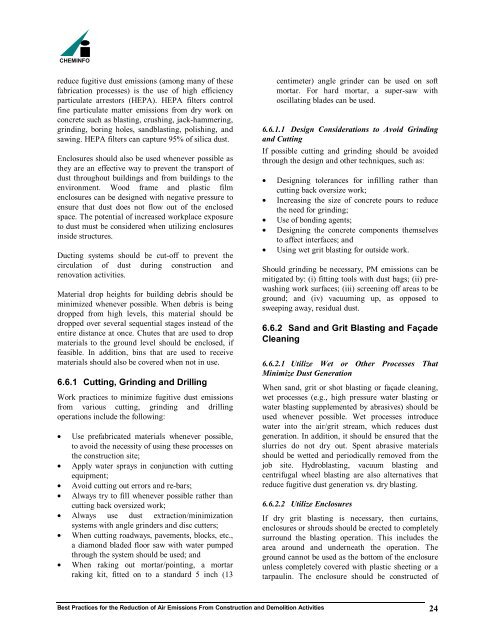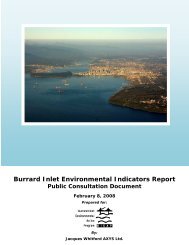Best Practices for the Reduction of Air Emissions From Construction ...
Best Practices for the Reduction of Air Emissions From Construction ...
Best Practices for the Reduction of Air Emissions From Construction ...
Create successful ePaper yourself
Turn your PDF publications into a flip-book with our unique Google optimized e-Paper software.
CHEMINFO<br />
reduce fugitive dust emissions (among many <strong>of</strong> <strong>the</strong>se<br />
fabrication processes) is <strong>the</strong> use <strong>of</strong> high efficiency<br />
particulate arrestors (HEPA). HEPA filters control<br />
fine particulate matter emissions from dry work on<br />
concrete such as blasting, crushing, jack-hammering,<br />
grinding, boring holes, sandblasting, polishing, and<br />
sawing. HEPA filters can capture 95% <strong>of</strong> silica dust.<br />
Enclosures should also be used whenever possible as<br />
<strong>the</strong>y are an effective way to prevent <strong>the</strong> transport <strong>of</strong><br />
dust throughout buildings and from buildings to <strong>the</strong><br />
environment. Wood frame and plastic film<br />
enclosures can be designed with negative pressure to<br />
ensure that dust does not flow out <strong>of</strong> <strong>the</strong> enclosed<br />
space. The potential <strong>of</strong> increased workplace exposure<br />
to dust must be considered when utilizing enclosures<br />
inside structures.<br />
Ducting systems should be cut-<strong>of</strong>f to prevent <strong>the</strong><br />
circulation <strong>of</strong> dust during construction and<br />
renovation activities.<br />
Material drop heights <strong>for</strong> building debris should be<br />
minimized whenever possible. When debris is being<br />
dropped from high levels, this material should be<br />
dropped over several sequential stages instead <strong>of</strong> <strong>the</strong><br />
entire distance at once. Chutes that are used to drop<br />
materials to <strong>the</strong> ground level should be enclosed, if<br />
feasible. In addition, bins that are used to receive<br />
materials should also be covered when not in use.<br />
6.6.1 Cutting, Grinding and Drilling<br />
Work practices to minimize fugitive dust emissions<br />
from various cutting, grinding and drilling<br />
operations include <strong>the</strong> following:<br />
• Use prefabricated materials whenever possible,<br />
to avoid <strong>the</strong> necessity <strong>of</strong> using <strong>the</strong>se processes on<br />
<strong>the</strong> construction site;<br />
• Apply water sprays in conjunction with cutting<br />
equipment;<br />
• Avoid cutting out errors and re-bars;<br />
• Always try to fill whenever possible ra<strong>the</strong>r than<br />
cutting back oversized work;<br />
• Always use dust extraction/minimization<br />
systems with angle grinders and disc cutters;<br />
• When cutting roadways, pavements, blocks, etc.,<br />
a diamond bladed floor saw with water pumped<br />
through <strong>the</strong> system should be used; and<br />
• When raking out mortar/pointing, a mortar<br />
raking kit, fitted on to a standard 5 inch (13<br />
centimeter) angle grinder can be used on s<strong>of</strong>t<br />
mortar. For hard mortar, a super-saw with<br />
oscillating blades can be used.<br />
6.6.1.1 Design Considerations to Avoid Grinding<br />
and Cutting<br />
If possible cutting and grinding should be avoided<br />
through <strong>the</strong> design and o<strong>the</strong>r techniques, such as:<br />
• Designing tolerances <strong>for</strong> infilling ra<strong>the</strong>r than<br />
cutting back oversize work;<br />
• Increasing <strong>the</strong> size <strong>of</strong> concrete pours to reduce<br />
<strong>the</strong> need <strong>for</strong> grinding;<br />
• Use <strong>of</strong> bonding agents;<br />
• Designing <strong>the</strong> concrete components <strong>the</strong>mselves<br />
to affect interfaces; and<br />
• Using wet grit blasting <strong>for</strong> outside work.<br />
Should grinding be necessary, PM emissions can be<br />
mitigated by: (i) fitting tools with dust bags; (ii) prewashing<br />
work surfaces; (iii) screening <strong>of</strong>f areas to be<br />
ground; and (iv) vacuuming up, as opposed to<br />
sweeping away, residual dust.<br />
6.6.2 Sand and Grit Blasting and Façade<br />
Cleaning<br />
6.6.2.1 Utilize Wet or O<strong>the</strong>r Processes That<br />
Minimize Dust Generation<br />
When sand, grit or shot blasting or façade cleaning,<br />
wet processes (e.g., high pressure water blasting or<br />
water blasting supplemented by abrasives) should be<br />
used whenever possible. Wet processes introduce<br />
water into <strong>the</strong> air/grit stream, which reduces dust<br />
generation. In addition, it should be ensured that <strong>the</strong><br />
slurries do not dry out. Spent abrasive materials<br />
should be wetted and periodically removed from <strong>the</strong><br />
job site. Hydroblasting, vacuum blasting and<br />
centrifugal wheel blasting are also alternatives that<br />
reduce fugitive dust generation vs. dry blasting.<br />
6.6.2.2 Utilize Enclosures<br />
If dry grit blasting is necessary, <strong>the</strong>n curtains,<br />
enclosures or shrouds should be erected to completely<br />
surround <strong>the</strong> blasting operation. This includes <strong>the</strong><br />
area around and underneath <strong>the</strong> operation. The<br />
ground cannot be used as <strong>the</strong> bottom <strong>of</strong> <strong>the</strong> enclosure<br />
unless completely covered with plastic sheeting or a<br />
tarpaulin. The enclosure should be constructed <strong>of</strong><br />
<strong>Best</strong> <strong>Practices</strong> <strong>for</strong> <strong>the</strong> <strong>Reduction</strong> <strong>of</strong> <strong>Air</strong> <strong>Emissions</strong> <strong>From</strong> <strong>Construction</strong> and Demolition Activities 24
















